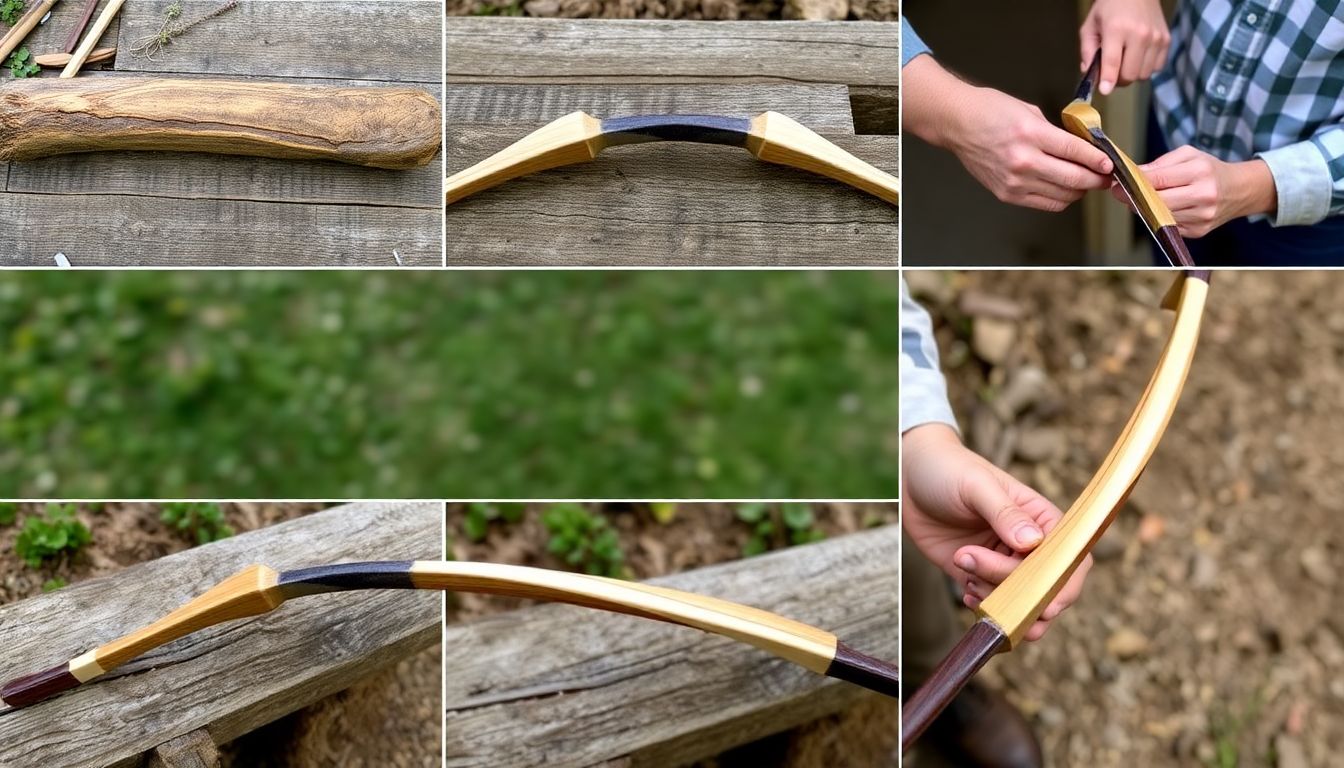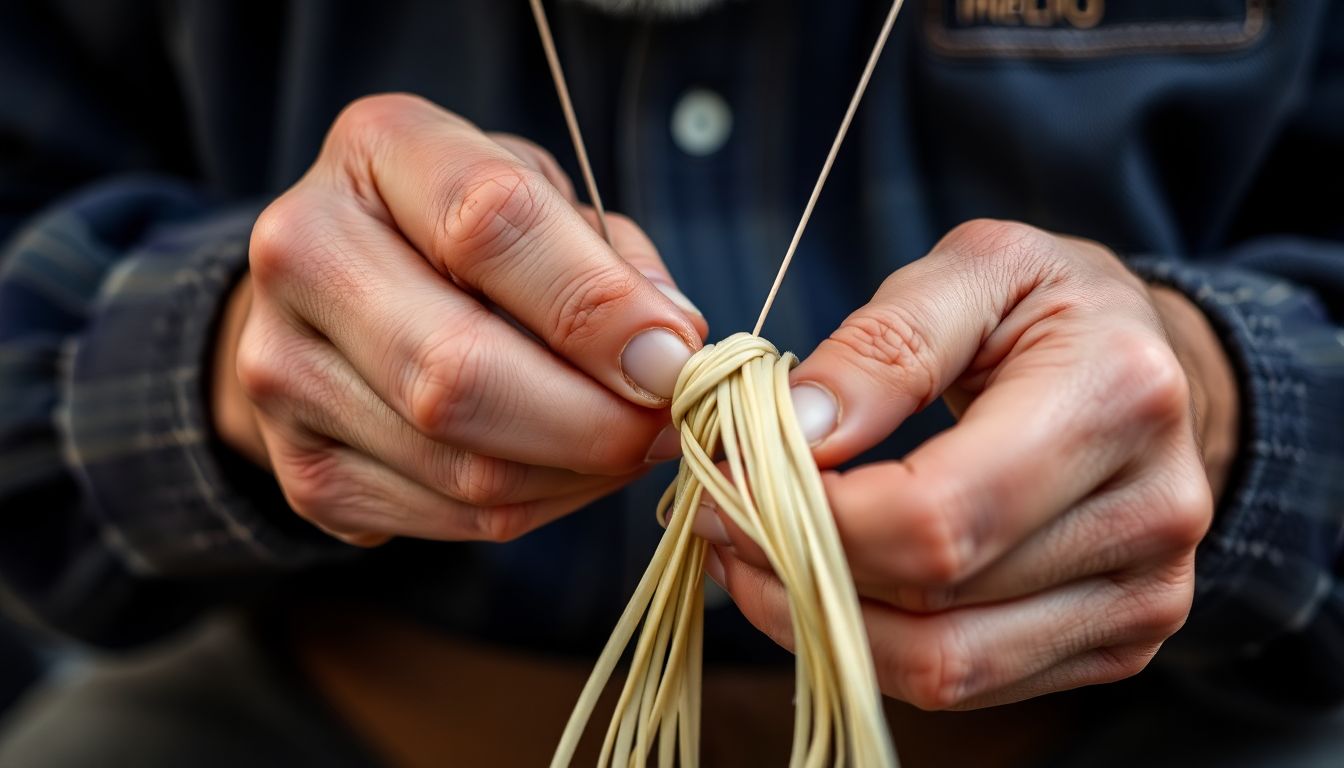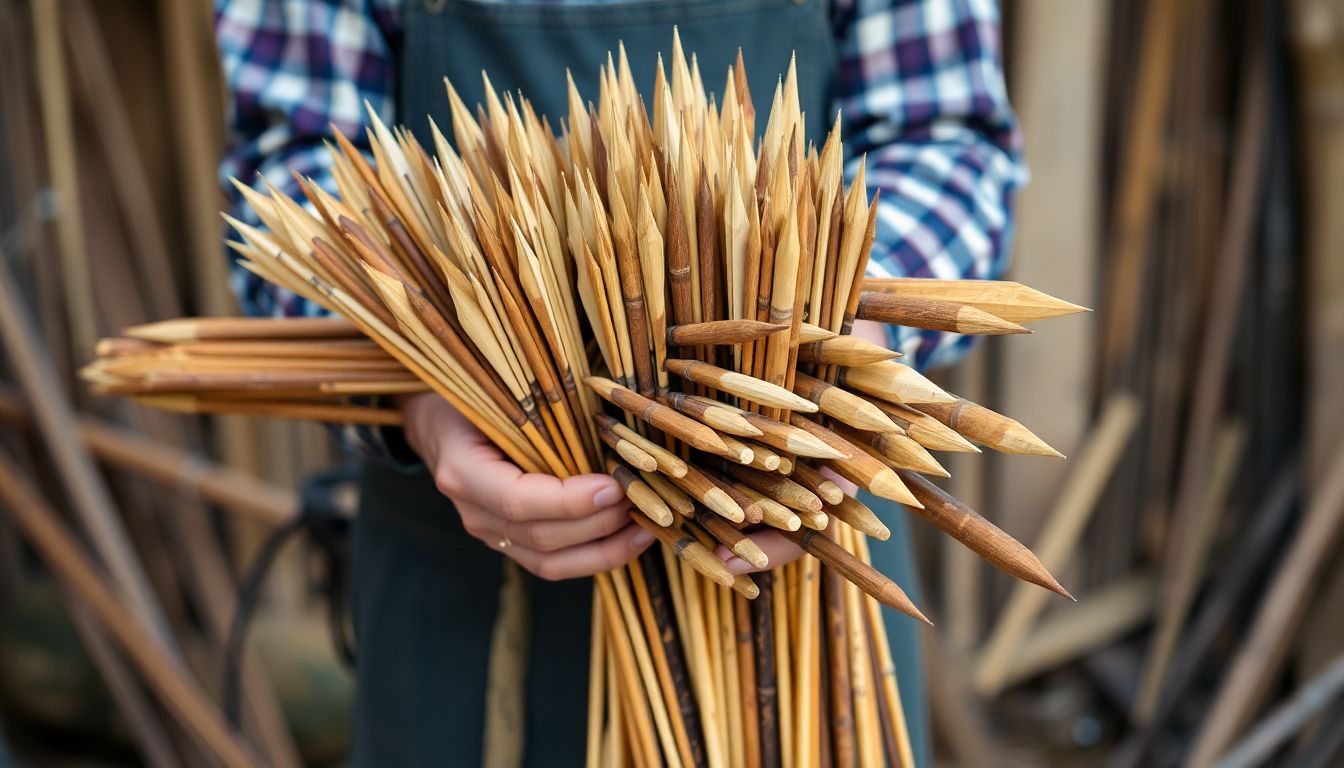Have you ever wondered how our ancient ancestors hunted for food, long before the advent of modern firearms and high-tech equipment? The answer lies in the timeless art of archery, a skill that has been passed down through generations and remains relevant even today in the realm of survival and primitive living. In this comprehensive guide, we delve into the fascinating world of survival archery, focusing on the crafting of primitive bows and the making of arrows, all while exploring the silent hunting techniques that have sustained human societies for millennia.
First, let’s address the elephant in the room: why should you, a modern individual, bother learning these ancient skills? The answer is twofold. Firstly, there’s the undeniable allure of self-sufficiency. In a world where we’re increasingly reliant on technology and convenience, there’s something deeply satisfying about creating your own tools and providing for your needs. Secondly, there’s the practical aspect. Whether you’re an avid camper, a prepper, or simply someone who enjoys learning new skills, knowing how to craft and use a primitive bow can be invaluable. According to a study by the National Shooting Sports Foundation, archery participation in the U.S. has been steadily increasing, with over 23.8 million participants in 2019. This growth is a testament to the enduring appeal of this ancient art.
Now, you might be thinking, ‘That sounds great, but where do I start?’ That’s where this article comes in. We promise to take you on a journey, from the selection of the right materials to the fine-tuning of your homemade bow. We’ll explore the different types of primitive bows, their pros and cons, and guide you through the process of making your own. We’ll also delve into the art of arrow making, discussing the various types of fletching, points, and shafts, and how to choose the right ones for your bow. But our journey doesn’t end there. We’ll also explore the silent hunting techniques that have been used by our ancestors for thousands of years, teaching you how to stalk your prey, read its behavior, and make the most of your handcrafted bow and arrows.
By the end of this article, you’ll not only have a deep understanding of survival archery, but you’ll also have the knowledge and skills to craft your own bow and arrows, and perhaps even bag your own game. So, whether you’re a seasoned survivalist or a curious beginner, grab your toolkit, step into the great outdoors, and let’s embark on this exciting adventure together.
Mastering the Art of Silent Hunting: Crafting and Utilizing Primitive Bows and Arrows
In the realm of silent hunting, the primitive bow and arrow stand as timeless, elegant tools, echoing the practices of our ancestors. Mastering their craft is not merely about stringing a bow and nocking an arrow; it’s a journey into the heart of nature, a dance with the wind, and a testament to human ingenuity. The process begins with the selection of materials
- the wood for the bow, the shaft for the arrow, the feathers for the fletching. Each choice is a step towards creating a unique, personal instrument, a silent symphony of survival. The crafting is a meditative process, a blend of skill and patience, as the wood is shaped, the string attached, and the arrow fletched. It’s a chance to connect with the natural world, to understand its rhythm and its strength. Once crafted, the bow and arrow become extensions of the hunter, an intimate partnership honed through practice and respect. The art of silent hunting is not about stealth alone, but about understanding, about becoming a part of the landscape, about moving with the grace and silence of the creatures you hunt. It’s about the thrill of the hunt, the satisfaction of providing for oneself, and the humbling experience of taking a life to sustain your own. It’s about the stories that come with each arrow, each kill, each lesson learned. It’s about mastering not just a tool, but a way of life, a silent, primal art that transcends time.

Understanding Primitive Bow Crafting
Primitive bow crafting, an ancient art form, has been a crucial survival skill for countless generations. It was not merely a hobby, but a necessity for hunting, defense, and even trade. The crafting process, passed down through generations, is deeply rooted in understanding the properties of wood and the anatomy of a bow.
The choice of wood is paramount in bow crafting. Different woods have unique properties that affect the bow’s performance. Some of the most suitable woods include yew, osage orange, and hickory. Yew, for instance, is known for its flexibility and strength, making it ideal for recurve bows. Osage orange, on the other hand, is dense and hard, providing excellent stability and accuracy. Hickory is another popular choice due to its resilience and ability to withstand heavy draw weights.
Selecting the right piece of wood involves careful inspection. Look for straight-grained wood with no knots or defects. The ideal piece should be slightly wider at the middle, tapering towards the ends, as this will help create a bow with a consistent bend and minimal hand shock.
The basic anatomy of a bow includes the handle (grip), the limbs (the curved part of the bow), and the tips (where the string is attached). The tools required for crafting a primitive bow are simple yet effective. You’ll need a knife for carving, a draw knife for shaping the limbs, a saw for cutting the wood to size, and a string for testing the bow’s draw weight and balance.
To craft a primitive bow, start by selecting your wood and cutting it to the desired length. Next, use the draw knife to carve the limbs, gradually removing wood until you achieve the desired thickness and curve. The handle should be carved to fit your hand comfortably. Once the basic shape is achieved, use the saw to cut notches for the string. Finally, attach the string and test your bow. Remember, primitive bow crafting is a skill that improves with practice, so don’t be discouraged if your first attempts aren’t perfect.

Crafting the Bow: Step-by-Step
Crafting a bow is an ancient art that combines patience, precision, and a deep respect for nature. The process begins with selecting the right wood, typically from species like yew, osage orange, or elm. The wood should be straight-grained, free from knots, and have a uniform color. Once chosen, the first step is to calculate the correct bow length. This is determined by measuring from the ground to the tip of your nose, then adding 4 to 6 inches for a traditional recurve bow. The wood is then stripped of its bark using a drawknife or a sharp knife, ensuring to remove all traces to prevent rot. The bow is then shaped using a wood rasp, starting from the handle and working outwards, creating a gentle curve known as the ‘riser’.
The next step involves creating the bow’s recurve, which gives it its power and efficiency. This is done by carefully carving the limbs, thinning them out from the back and leaving the belly thicker. The recurve should be subtle, not too pronounced, as this affects the bow’s balance and stability.
Proper drying and seasoning are crucial for the longevity and performance of the bow. The wood should be dried slowly and evenly, ideally in a controlled environment with a humidity of around 50% and a temperature between 60-70°F. This process can take anywhere from six months to a year. Once dried, the bow is ready for stringing. The string is attached to the nocks, which are notches carved into the ends of the bow. The string is then twisted and tied using a simple overhand knot, ensuring it’s secure and taut. The final step is to apply a finish, like linseed oil or shellac, to protect the bow and enhance its beauty. And there you have it, a handcrafted bow, ready to whisper through the air and dance with the wind.

Creating the Bowstring
Creating a bowstring from natural materials is an ancient craft that requires patience, skill, and a deep understanding of the materials at hand. The process begins with selecting the right material, which could be sinew, rawhide, or plant fibers like linen or hemp. Each material has its unique properties, but all must be prepared carefully to ensure the string’s longevity and strength.
The first step in preparing sinew involves removing it from the animal’s leg in a single, continuous piece. It’s then scraped clean of any remaining flesh and tendons, and soaked in water to soften it. For rawhide, the process is similar, with the hide being soaked, scraped, and then pounded to remove any remaining hair and to soften it. Plant fibers, on the other hand, are often twisted into strands before being plaited together.
Once the material is prepared, the next step is to twist it into a cord. This is done by holding one end of the material in each hand and twisting them in opposite directions. The more the material is twisted, the stronger the string will be, but it’s important not to twist it too much, as this can cause the string to break under tension.
Tension is a crucial aspect of bowstring making. The string must be able to withstand the force exerted by the bow when it’s drawn, and it must also be able to maintain that tension over time. To test the string’s strength, it can be placed under tension using a simple device called a string tester. This involves tying the string to a fixed point, then pulling on it with a known force to see if it stretches or breaks.
Once the string has been tested and found to be strong enough, it’s time to attach it to the bow. This is done by tying a specific knot, such as the serving knot or the timber hitch, which distributes the tension evenly along the string. The string is then nocked onto the bow, and the process of creating a bowstring is complete. This ancient craft, passed down through generations, is a testament to the ingenuity and resourcefulness of our ancestors, and it continues to be practiced today by those who appreciate the beauty and functionality of handmade tools.

Crafting Arrows: Choosing the Right Wood
Crafting arrows, an ancient art, begins with selecting the right wood for your arrow shafts. The ideal wood is straight-grained, dense, and durable. Let’s explore some suitable types.
Types of Wood and Their Properties:
- Port Orford Cedar: Known for its straight grain and high density, it’s a favorite among archers. It’s lightweight, strong, and resists warping.
- Osage Orange: This wood is incredibly hard and durable, making it excellent for traditional archery. It’s heavy, so it’s not ideal for high-speed bows.
- Hickory: A classic choice, hickory is strong and flexible. It’s heavier than other options, but it’s durable and resistant to shock.
- Maple: Lightweight and stiff, maple is great for high-speed bows. It’s not as durable as other woods, so it’s best for target archery.
Once you’ve chosen your wood, it’s time to prepare it. Start by selecting a straight piece. If it’s not perfectly straight, you can straighten it using a woodworking vice and a drawknife. Slowly and carefully shave off the high spots until it’s straight.
Next, dry the wood to prevent warping. You can do this naturally by hanging it in a cool, dry place for several months, or speed up the process with a dehumidifier. The goal is to get the moisture content down to around 8-10%.
With the right wood, properly straightened and dried, you’re ready to craft arrows that are straight, durable, and a joy to shoot.

Shaping and Fletching Arrows
Crafting arrows is an art that combines precision, patience, and a touch of creativity. Let’s embark on a journey to shape, nock, and fletch your arrows, ensuring they soar through the air with grace and accuracy.
Shaping the Arrow Shaft:
Begin with a straight, uniform arrow shaft. This could be made from wood, carbon, or aluminum, each offering unique advantages. For this guide, let’s use a wooden shaft. First, ensure the shaft is straight by rolling it on a flat surface. If it wobbles, it’s not straight and may need to be planed or sanded. Once straight, cut the shaft to your desired length, typically around 28-32 inches for a standard recurve bow.
Creating the Nock:
The nock is the notch at the end of the arrow that rests on the bowstring. It can be made from plastic, metal, or self-nocking, where you carve the nock directly into the shaft. For a self-nocking arrow, mark the center of the shaft, then carefully carve a V-shape using a sharp knife. Ensure the nock is deep enough to securely hold the bowstring but not so deep that it weakens the shaft.
Adding Fletching:
Fletching is crucial for arrow flight stability. It can be made from various materials like feathers, plastic vanes, or even bird of paradise (BOP) feathers. Each has its pros and cons, but feathers are traditional and offer excellent stability.
Feather Fletching:
Preparation:
- Gather your feathers, a sharp knife, fletching jig, glue, and a clamp. The jig ensures consistent fletching placement and angle.
Attach the Feather:
- Place the feather in the jig, with the vane facing the direction of flight. Apply a small amount of glue to the base of the feather, then press it firmly onto the arrow shaft. Use the clamp to hold it in place until the glue sets.
Trimming:
Once the glue is dry, trim the excess feather with a sharp knife, ensuring a smooth, streamlined surface.
Plastic Vane Fletching:
Preparation:
- Similar to feathers, gather your vanes, a sharp knife, fletching jig, glue, and a clamp.
Attach the Vane:
- Place the vane in the jig, with the rounded edge facing the direction of flight. Apply glue to the base of the vane, then press it firmly onto the arrow shaft. Use the clamp to hold it in place until the glue sets.
Trimming:
Once the glue is dry, trim any excess vane material.
Optimizing Flight:
The angle at which you attach the fletching significantly impacts arrow flight. For right-handed archers, the feathers or vanes should face clockwise when looking at the nock end of the arrow. This causes the arrow to spin clockwise in flight, stabilizing its path. The ideal angle is typically around 4-6 degrees, but this can vary based on personal preference and the specific arrow and bow setup.
With these steps, you’ve crafted arrows ready to take flight. The process may seem daunting at first, but with practice, you’ll find a rhythm, and each arrow will tell a story of your craftsmanship.

Making Arrow Points: Stone, Metal, and Bone
Crafting arrow points is an art that has evolved over centuries, with various materials being utilized to create these essential components of archery. Let’s delve into the process of making arrow points from stone, metal, and bone, exploring their unique advantages and disadvantages, and how to attach them to the arrow shaft.
Stone Points:
The earliest arrow points were crafted from stone, with flint being a popular choice due to its sharpness and durability. To create a stone point, select a suitable stone, such as flint or chert, and carefully shape it using a hammerstone and pressure flaking. This involves applying controlled pressure to the stone’s edge to remove small flakes, gradually shaping it into a point. Stone points are durable and can maintain their edge longer than other materials, but they are also heavier and more prone to breakage.
Metal Points:
Metal points, typically made from brass, aluminum, or steel, offer a balance between durability and weight. To create a metal point, you’ll need a metalworking kit, including metal stock, a saw, files, and a drill. Cut the metal stock into the desired shape, then use files to refine the shape and create the point. Drill a hole at the base for attachment to the arrow shaft. Metal points are lighter than stone, easier to attach, and can be resharpened, but they may not maintain their edge as long as stone points.
Bone Points:
Bone points, usually crafted from animal bones, offer a unique aesthetic and are lightweight. To create a bone point, first, clean and dry the bone, then use a saw or knife to cut it into the desired shape. Sand the bone smooth and drill a hole at the base for attachment. Bone points are lightweight and can be quite beautiful, but they are also more fragile than stone or metal points and may not maintain their edge as well.
Attaching the Points:
Once you’ve crafted your arrow point, it’s time to attach it to the arrow shaft. This can be done using various methods, such as gluing, wrapping, or using a socketed shaft. For gluing, apply a thin layer of adhesive to the base of the point and the end of the shaft, then insert the point and allow it to dry. For wrapping, use sinew, thread, or wire to wrap the base of the point, securing it to the shaft. Socketed shafts involve carving a socket into the end of the shaft, into which the point is inserted and secured with adhesive or a peg. Each method has its advantages and disadvantages, so choose the one that best suits your needs and preferences.

Stringing and Serving the Bow
Stringing and serving a bow is an essential skill for archers, ensuring your equipment is in optimal condition for consistent and safe shooting. Let’s dive into the process, step by step.
Stringing the Bow:
Begin by unstringing your bow if it’s already strung. Hold the bow with the handle facing you, and the string nock (the loop at the end) facing away. Insert the nock into the corresponding nock point on the bow’s limb. Pull the string towards you, guiding it through the shelf (the groove where the arrow rests) and the other nock point. Once the string is through, pull it taut and secure it with a serving or a string loop knot.
Applying Serving to Protect the String:
Serving is a protective layer that prevents the string from fraying and protects your bow’s limbs. It’s typically made of synthetic materials like Dacron or Kevlar. To apply serving, start at the center of the bowstring, where the serving will be thickest. Wrap the serving material around the string, pulling it taut as you go. Ensure the serving is even and covers the entire string where it contacts the bow’s limbs. Secure the serving with a knot or a dab of glue.
Maintaining the Bow’s String and Serving:
- Regular maintenance is key to prolonging the life of your bowstring and serving.
- Inspect your string and serving regularly for signs of wear, such as fraying, stretching, or loss of serving material.
- Wipe down your bowstring with a damp cloth after each use to remove dirt and debris. Allow it to dry completely before storing.
- Store your bow in a cool, dry place, away from direct sunlight and heat sources that can degrade the string and serving.
- Consider using a string silencer or string dampener to reduce vibration and wear on the string and serving.
With proper care and maintenance, your bow’s string and serving can last for many enjoyable hours of shooting.

Testing and Tuning Your Primitive Bow
Crafting a primitive bow is a rewarding experience, but it’s just the beginning of your journey with this versatile tool. Once you’ve fashioned your bow from a carefully selected piece of wood, it’s time to test and tune it for optimal performance. Regular maintenance will ensure your bow remains in top condition, ready for whatever adventures you have in mind.
The first step in testing your newly crafted bow is to check its tiller. This refers to the bow’s symmetry and balance. Hold the bow at the handle and gently bend it. The top and bottom limbs should bend evenly, with no significant difference in their curvature. If the tiller is off, you may need to adjust the limb thickness or the handle’s position.
Next, it’s time to string your bow. This can be a challenging task, but with patience and care, you can do it. Start by placing the string on the bottom limb, then carefully bend the limb upwards to meet the string. Once the string is on the nock point, repeat the process with the top limb. Remember, it’s easier to string a bow when it’s dry, so avoid stringing it after it’s been exposed to moisture.
Now that your bow is strung, it’s time to tune it. The first thing to check is the brace height. This is the distance from the grip to the string when the bow is at rest. A good starting point is to set the brace height at about 6 to 7 inches. This can be adjusted by moving the grip up or down the handle.
Once you’ve set the brace height, it’s time to check the bow’s draw weight and length. The draw weight is the amount of force required to pull the string back to the full draw position. The draw length is the distance the string travels from the rest position to the full draw position. These measurements can be adjusted by moving the grip or by adding or removing material from the limbs.
Regular maintenance is crucial to keep your bow in top condition. This includes inspecting the bow for any signs of wear or damage, such as cracks or splinters. If you notice any issues, address them promptly to prevent further damage. Also, keep your bow dry and store it in a cool place when not in use. With proper care and tuning, your primitive bow will serve you well for many years to come.

Silent Hunting Techniques with a Primitive Bow
In the realm of silent hunting, the primitive bow stands as a timeless and formidable tool, offering advantages that modern firearms cannot match. Its primary asset is stealth; the bow’s release is virtually silent, allowing hunters to approach game undetected. This quiet approach enables hunters to get closer to their prey, increasing the likelihood of a successful hunt. Moreover, primitive bows require a level of skill and precision that fosters a deeper connection with the hunt, making it a rewarding and challenging experience.
The art of silent hunting with a primitive bow relies heavily on stealth and surprise. Stalking game requires patience, keen observation, and a deep understanding of the animal’s behavior. Hunters must move slowly and deliberately, using cover to their advantage, and anticipating the animal’s movements. It’s crucial to blend into the environment, using camouflage and natural movements to avoid detection.
Proper shot placement is vital for a quick and humane kill. The heart-lung area is the most effective target, as it ensures a swift and silent end to the animal’s life. This requires accurate aim and a deep understanding of the animal’s anatomy. Practice is key, and hunters should spend time at the range honing their skills.
Tracking is another essential aspect of silent hunting. After an animal is taken, the hunter must be able to follow its trail, often in low light or challenging conditions. This requires a keen eye for detail and an understanding of animal behavior. Hunters should look for signs such as broken twigs, disturbed leaves, or blood trails. By following these signs, the hunter can recover their game and ensure that no part goes to waste.
In conclusion, the primitive bow offers a unique and challenging way to hunt, relying on stealth, skill, and patience. Whether you’re a seasoned hunter or a beginner, mastering the art of silent hunting with a primitive bow can provide a deeper connection to the natural world and a greater appreciation for the animals we hunt.

Ethical Considerations in Primitive Bow Hunting
Ethical considerations in primitive bow hunting are multifaceted and deeply rooted in the principles of fair chase, respect for the game, and responsible harvesting. Primitive bow hunting, which involves the use of traditional archery equipment without modern aids like sights or stabilizers, presents unique challenges and opportunities for hunters to engage in a more primal, intimate, and ethical hunting experience.
The concept of fair chase is paramount in primitive bow hunting. This principle advocates for a hunting scenario where the odds are balanced between the hunter and the hunted. It encourages hunters to use their skills, knowledge, and physical abilities to pursue game, rather than relying on technological advantages. This not only makes the hunt more challenging but also ensures that the animal has a fair opportunity to evade capture. For instance, hunters may choose to pursue game on foot, using calls, or employing other strategies that mimic natural predation.
Respect for the game is another crucial ethical consideration. This respect is not just about the moment of the kill but extends to the entire process of hunting. It involves understanding the animal’s habits, needs, and vulnerabilities. Respectful hunters take time to learn about their prey, ensuring they are targeting healthy, mature animals that have contributed to the gene pool. They also strive to minimize suffering, practicing accurate shooting and humane tracking techniques.
Responsible harvesting is the third pillar of ethical primitive bow hunting. This involves more than just the act of killing; it encompasses the entire process from start to finish. Responsible hunters ensure they have the necessary skills and knowledge to humanely dispatch an animal and then process it efficiently to minimize waste. They also practice sustainable hunting, adhering to bag limits and regulations, and supporting conservation efforts through their license fees and donations.
Ironically, primitive bow hunting plays a significant role in conservation efforts. By promoting sustainable hunting practices, it helps to control wildlife populations, preventing overgrazing and disease spread. Moreover, the revenue generated from hunting licenses and tags often goes directly into conservation and habitat restoration projects. Additionally, primitive bow hunting encourages a deeper connection with nature, fostering a sense of stewardship and responsibility among hunters.
In conclusion, primitive bow hunting, when approached ethically, can be a powerful tool for conservation and a deeply meaningful hunting experience. It encourages hunters to engage with their prey on a more intimate level, promoting respect, responsibility, and a commitment to fair chase. By embracing these ethical considerations, primitive bow hunters can ensure that their pursuit is not just a thrilling challenge, but also a responsible and sustainable one.
FAQ
What is the first step in crafting a primitive bow?
How do I determine the correct length for my bow?
What is the ‘riser’ and ‘limbs’ of a bow, and how do I shape them?
How do I attach the string to my bow?
What materials can I use to make arrows for my primitive bow?
How do I fletch my arrows?
What is the ‘poundage’ of a bow, and how do I determine what’s right for me?
How can I practice silent hunting with my primitive bow?
- Choose your hunting ground carefully. Look for areas with dense cover, where you can approach game undetected.
- Move slowly and deliberately, placing each foot carefully to avoid making noise.
- Use the wind to your advantage. Game animals have a keen sense of smell, so try to position yourself downwind of your target.
- Practice stalking and still-hunting techniques. These involve moving slowly and deliberately, using cover to your advantage, and taking advantage of the element of surprise.
- When you’re ready to take a shot, make sure you have a clear line of sight and a stable shooting position. Take a deep breath, exhale slowly, and release the arrow smoothly.









